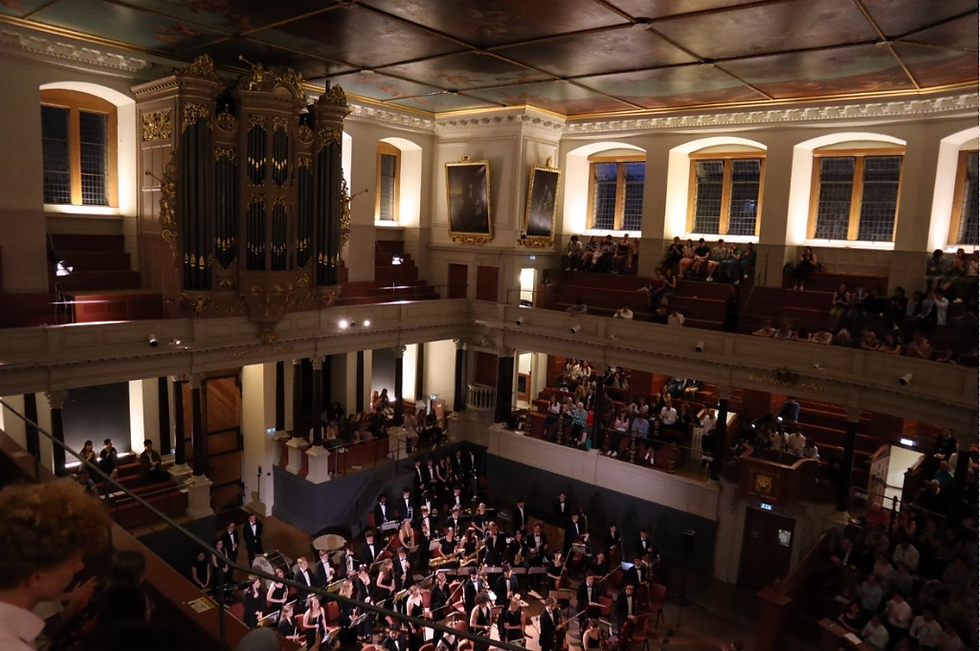Review: Oxford University Sinfonietta, MT18
- Evie Brenkley

- Dec 3, 2018
- 4 min read

by Anton Blackburn
This evening’s programme, attentively performed by the Oxford University Sinfonietta and conducted by Tom Fetherstonhaugh in the stunning University Church of St Mary the Virgin, led its listeners through a variety of emotions starting with the complex devastation and grief expressed in MacMillan’s Tuireadh, and leading to the triumph of Beethoven’s famous Sinfonia Eroica. Between the two, Copland’s Appalachian Spring was aptly placed: having survived the devastating and technically brilliant performance of Tuireadh, Appalachian Spring acted as a spiritual bridge, allowing a sense of catharsis before the interval.
Tuireadh, Gaelic for ‘lament for the dead’, is dedicated to the victims of the Piper Alpha disaster which took place on a Scottish off-shore oil and gas platform on 6 July 1988. The programme described Tuireadh as an attempt to capture the outpouring of grief caused by this tragedy, which, indeed, this performance certainly captured. The opening solo-clarinettist, Dan Mort, set an enigmatic scene; he opened with a barely-audible pianissimo, which conjured a still image while the extreme-crescendo made the mood unclear. Yet this was thrown aside by an aggressive explosion from the string leaders – each interjection was well-measured and controlled, adding new colour and dynamic to the already unsettling atmosphere. The leader of the seconds, Kata Oldland, stood out in the opening string quartet with a satisfyingly rich tone. The ensemble’s considerate accompaniment and collective sound came across as more mature and expressive as the piece progressed through moments of tragedy and tension. Most impressive were the expertly-controlled, self-described ‘shrieks’ of the clarinet that often pierced the wall of sound created by the strings. Also noteworthy were the conversational exchanges between the clarinet and the leader, Charlie Lovell-Jones; both performers displayed intense technical-ability and evoked a sense of unstable-rapidity. The piece ended with a beautiful viola solo played by Will Emery: it was a well-played, pained and longing ending to the piece. The Sinfonietta’s performance of Tuireadhwas, indeed, the highlight of the evening, ending with the faintest vestige of sound. Applause felt strangely inappropriate, owing to both the near-silent ending and the raw-emotions presented.
Copland’s Appalachian Spring was a delightfully pastoral and charming contrast to the horrors of the MacMillan. Verily, the reduced strings and new ensemble created a fresh, open atmosphere allowing the group to show off their brighter, more light-hearted side. Following the idyllic opening, we have a suddenly more active and lively section that was well driven by the leader, who displayed passion both physically and sonically. The star of the woodwind section, David Brunner, had stunning, pure entries on the bassoon and a superbly controlled pianissimo. In the chorale sections, the expressivity of the cello section actually stood out during the precise togetherness of the whole ensemble. In these sections, Fetherstonhaugh provided expressive gestures which were responded to carefully and promptly. The well-known folk-tune,The Gift to Be Simple, embedded within the penultimate section, was played well but quite tentatively by the solo-clarinettist, Will Harwood; nonetheless, a firmer statement of the tune was played with panache by the cellists. The coda was particularly moving: the flautist (Lucy Buxton), bassoonist, and double-bassist (Samuel Hopkins), provided a stunning texture that was genuinely moving and unforgettable. The final few statements of the A, C, F, E motif – fitting with the folk-like fashion of the piece – were a touching end to a stunning, responsive, and expressive interpretation.
After an emotionally necessary interval, we then began an impressive performance of Beethoven’s 3rdSymphony. The iconic Eb major theme of the Allegro con brio with the sensual C# was tastefully played by the celli, led with éclat by Angus McCall. The overall balance of the movement was at times not in favour of the woodwind section and their colourful interjections. It must be said, however, that the string section were perfectly together throughout and the leader maintained his omnipresent confidence and brio. The Adagio was beautifully played with notable contributions from the celli who were, again, sensitive to the conductor’s gestures. Whilst showing technical capability, the oboist, Sarah Moorehouse, lacked expression but was rescued by stunning entries from the bassoonist and clarinettist, Emily Hazrati. Hazrati’s bright sound was complemented nicely by David’s pure and mellow tone; together, they make an impressive duo. It was in this movement that Fetherstonhaugh’s choral-conducting background was serviceable, resulting in lyrical gestures that inspired a sensitive and solemn interpretation from the performers. In the Scherzo, we had a revival of the heroic mood and the power of the horn section really stood out. In the beginning of the movement, the flautist played spritely and added appropriate colour. The movement ended confidently and moved swiftly into the Finale, the beginning of which was fiery and sassy. It would have been nice to see more direction from the conductor at certain points, particularly for the woodwind; however, the tempo was firmly held and strings were well-guided with low entries being brought out nicely. The coda was blazingly dramatic with a clear drive from all players: astonishingly, the performers still had energy after this ambitious programme. Needless to say, the Eroica seemed to be the audience-favourite and deserved the rapturous applause it received.
The Oxford University Sinfonietta presented its audience with a profoundly diverse, challenging, and sophisticated performance which was altogether moving and exciting. They displayed their versatility as individual and cooperative performers. Indeed, the Sinfonietta is one of the most professional and impressive ensembles in the Oxford music scene. I am certainly look forward to their next concert.








Comments